can you please rewrite this business case based on the points highlighted in blue
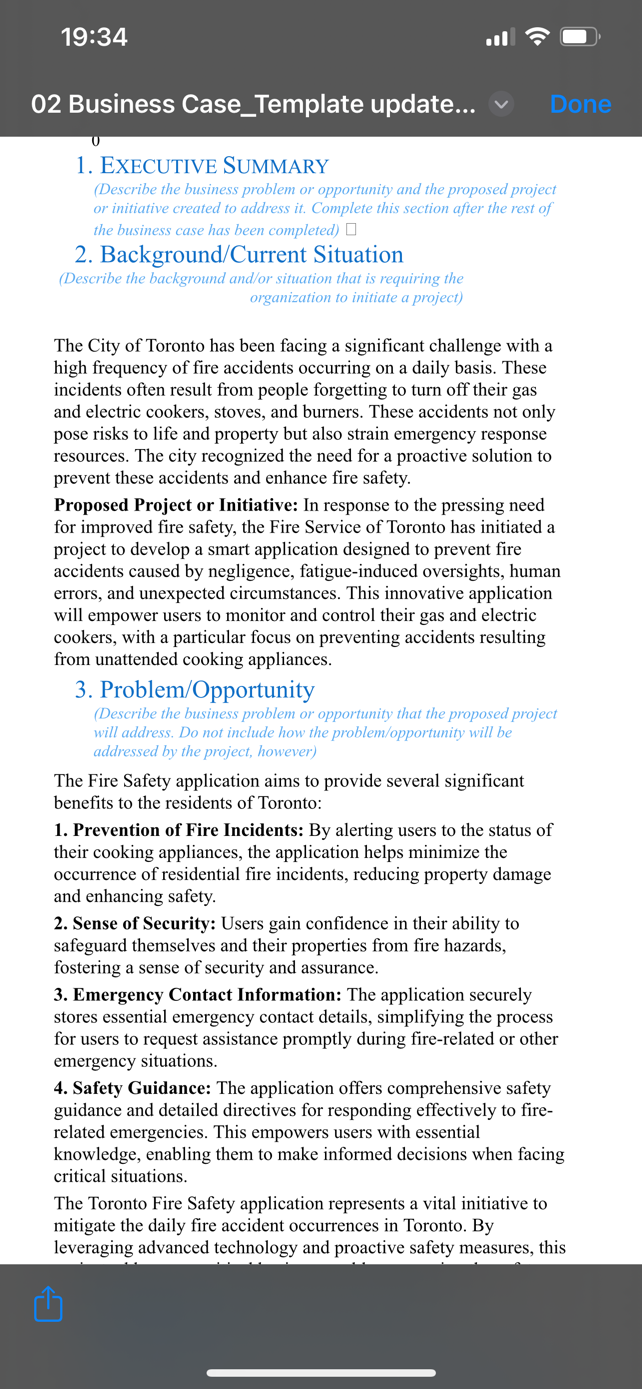
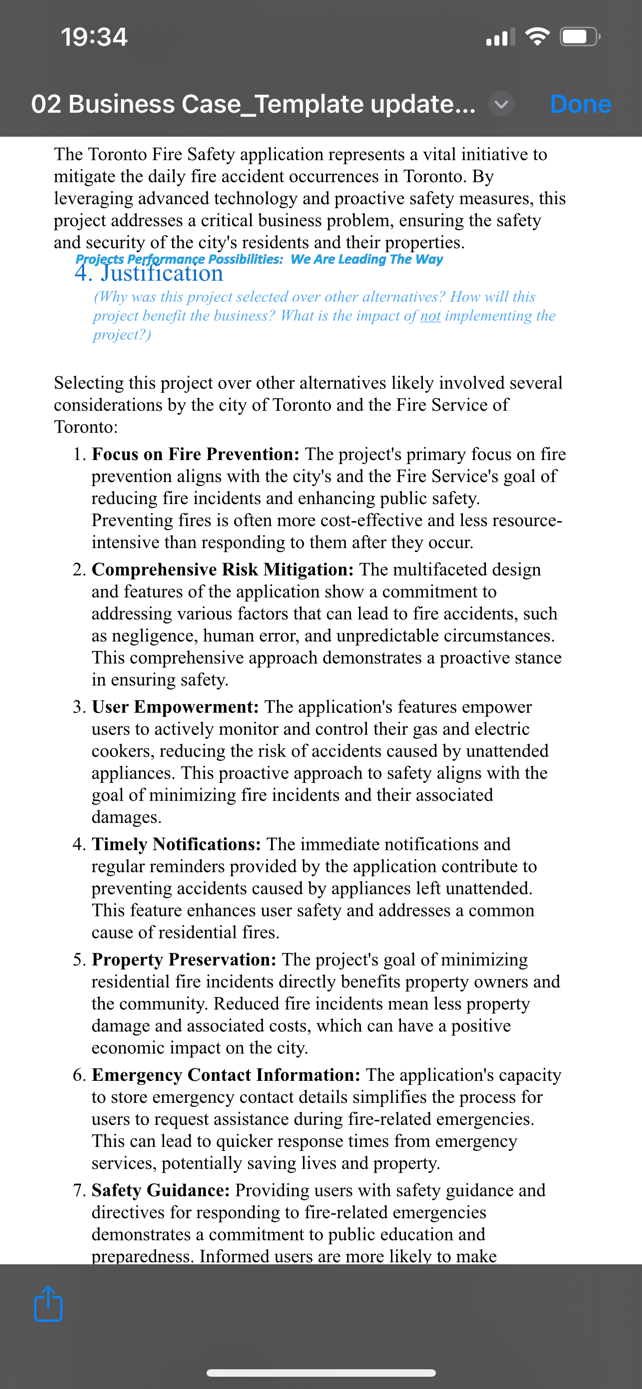

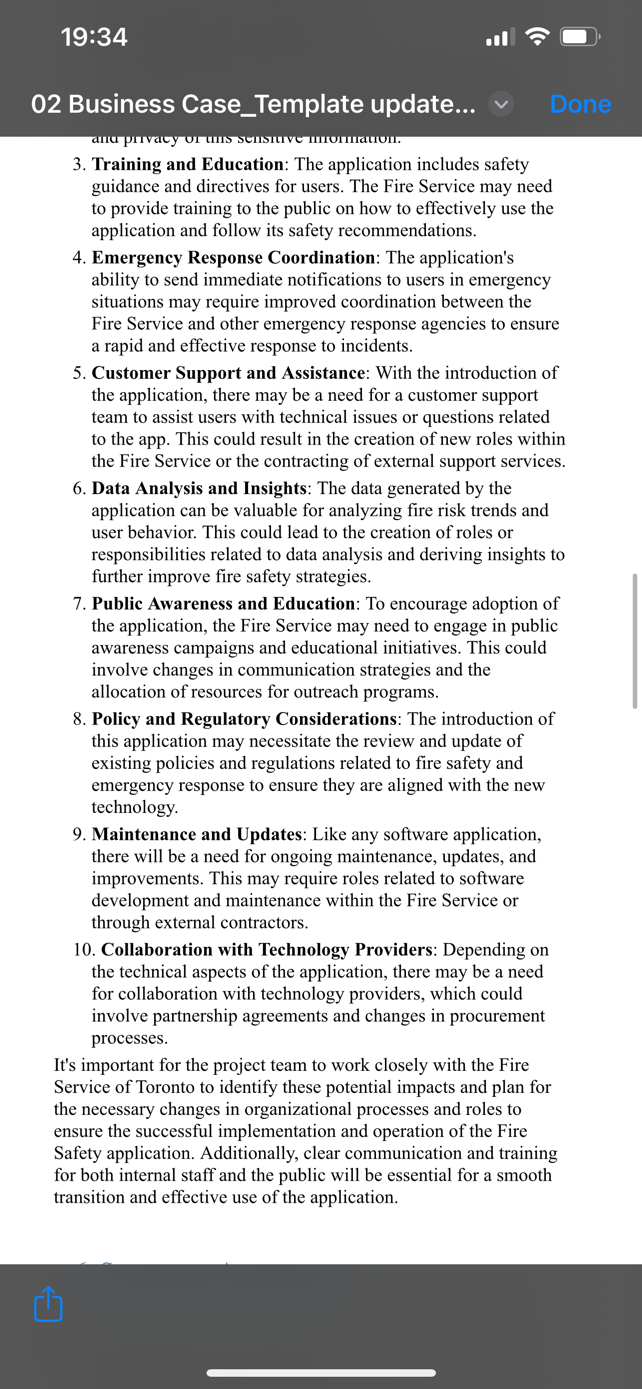
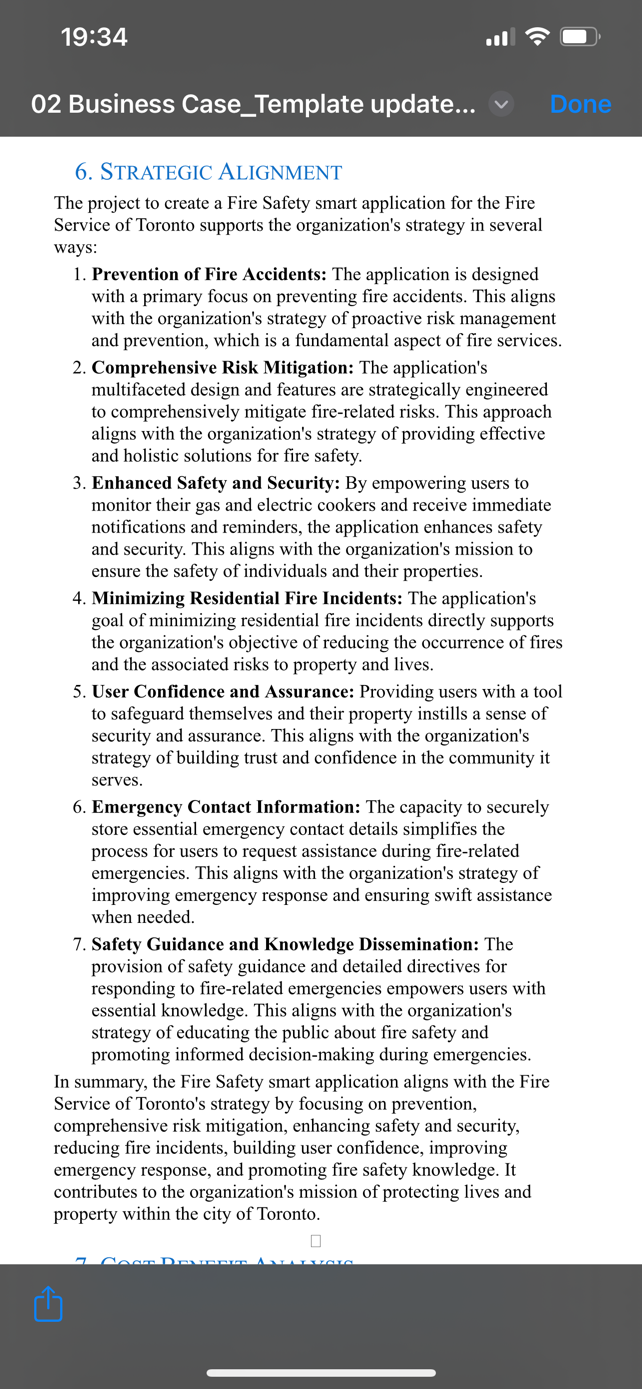
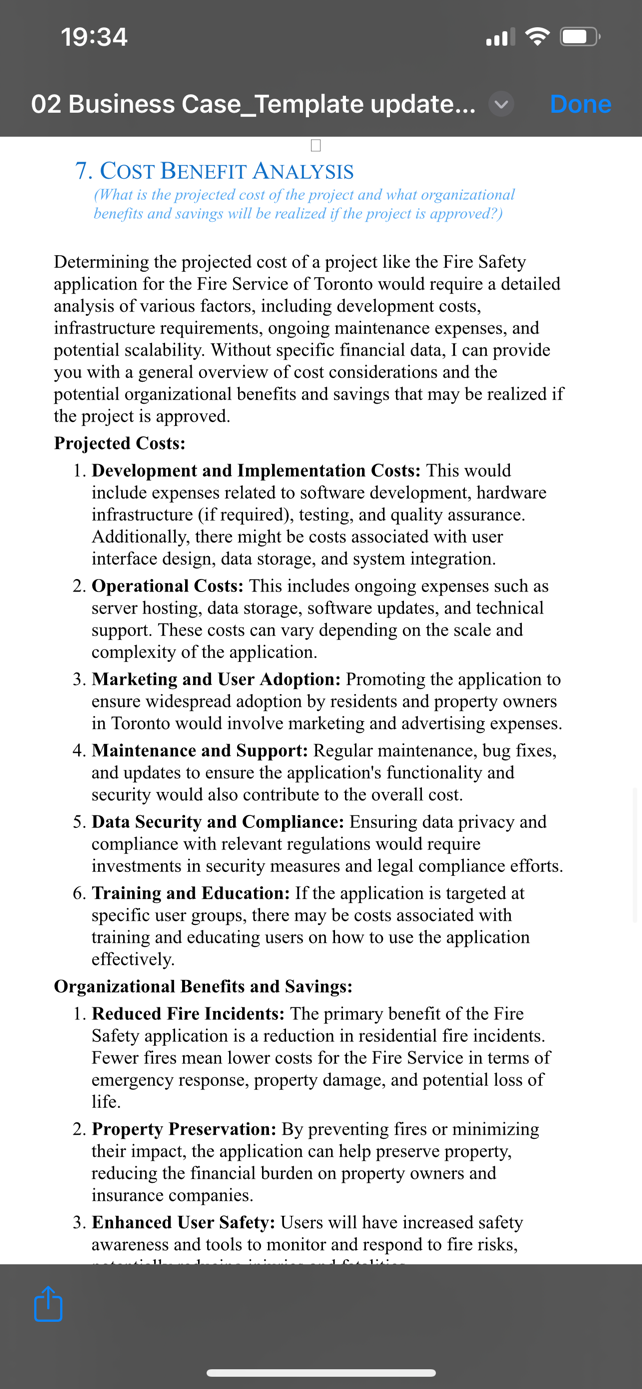
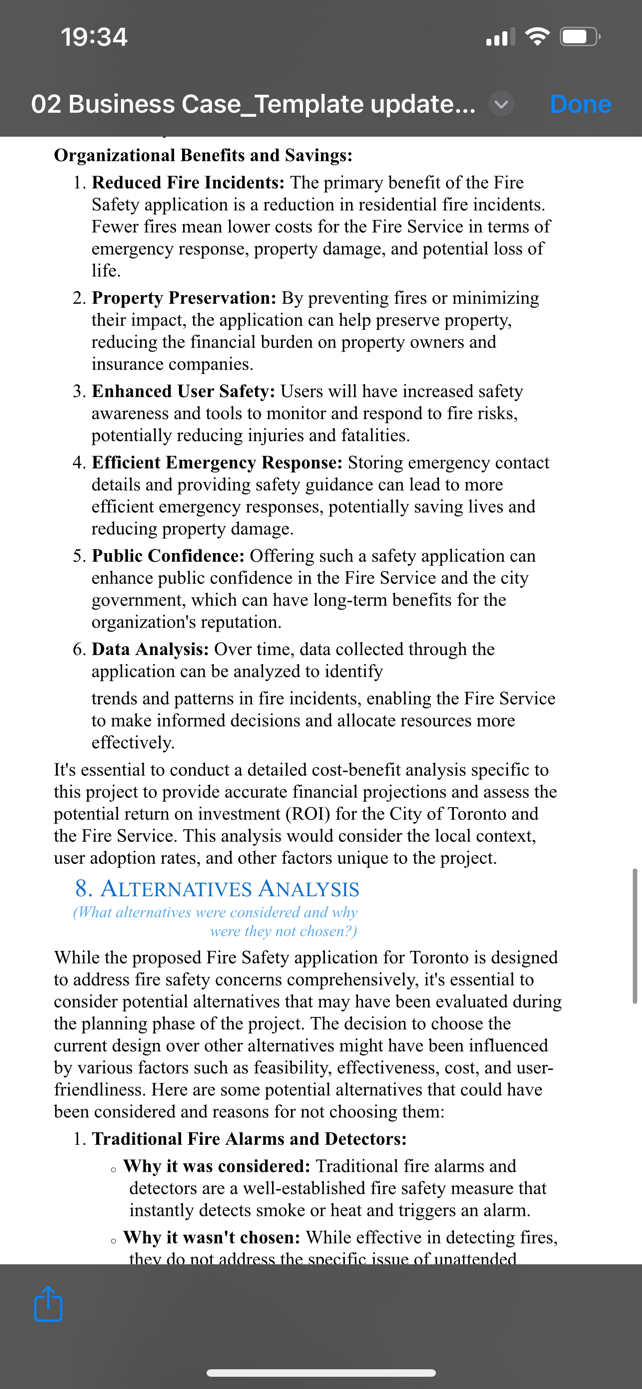

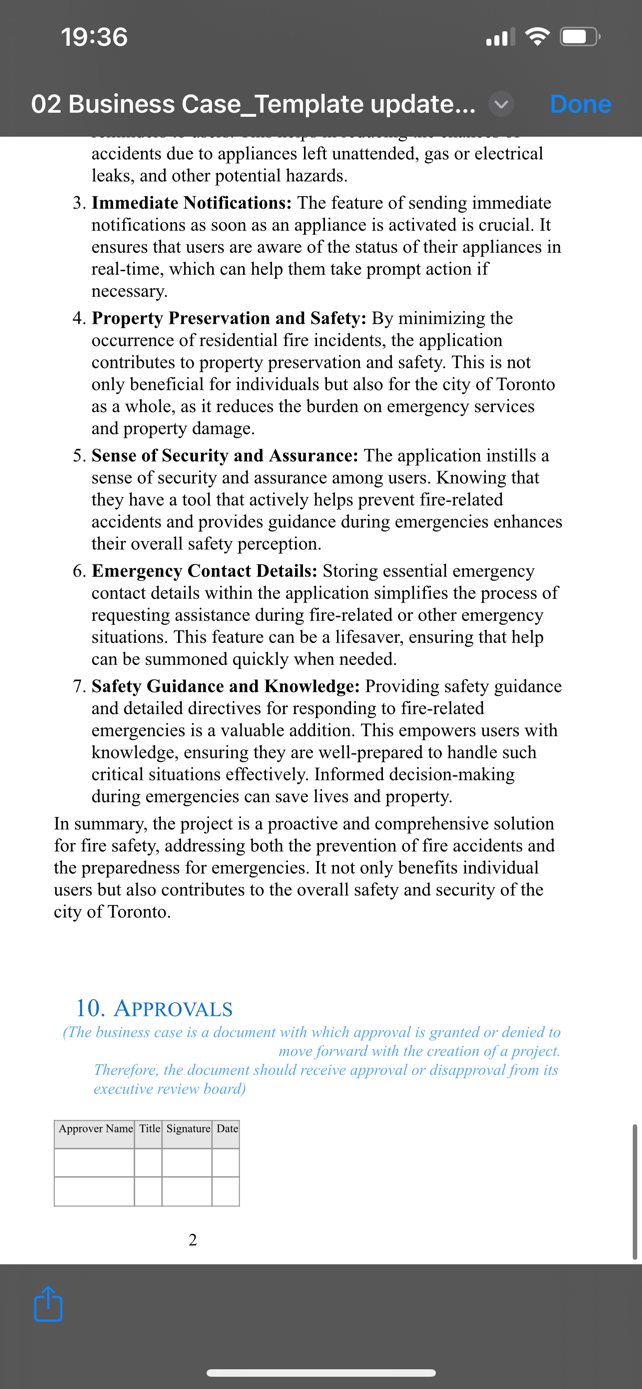
7. COST BENEFIT ANALYSIS (What is the projected cost of the project and what organizational benefits and savings will be realized if the project is approved?) Determining the projected cost of a project like the Fire Safety application for the Fire Service of Toronto would require a detailed analysis of various factors, including development costs, infrastructure requirements, ongoing maintenance expenses, and potential scalability. Without specific financial data, I can provide you with a general overview of cost considerations and the potential organizational benefits and savings that may be realized if the project is approved. Projected Costs: 1. Development and Implementation Costs: This would include expenses related to software development, hardware infrastructure (if required), testing, and quality assurance. Additionally, there might be costs associated with user interface design, data storage, and system integration. 2. Operational Costs: This includes ongoing expenses such as server hosting, data storage, software updates, and technical support. These costs can vary depending on the scale and complexity of the application. 3. Marketing and User Adoption: Promoting the application to ensure widespread adoption by residents and property owners in Toronto would involve marketing and advertising expenses. 4. Maintenance and Support: Regular maintenance, bug fixes, and updates to ensure the application's functionality and security would also contribute to the overall cost. 5. Data Security and Compliance: Ensuring data privacy and compliance with relevant regulations would require investments in security measures and legal compliance efforts. 6. Training and Education: If the application is targeted at specific user groups, there may be costs associated with training and educating users on how to use the application effectively. Organizational Benefits and Savings: 1. Reduced Fire Incidents: The primary benefit of the Fire Safety application is a reduction in residential fire incidents. Fewer fires mean lower costs for the Fire Service in terms of emergency response, property damage, and potential loss of life. 2. Property Preservation: By preventing fires or minimizing their impact, the application can help preserve property, reducing the financial burden on property owners and insurance companies. 3. Enhanced User Safety: Users will have increased safety awareness and tools to monitor and respond to fire risks, The Toronto Fire Safety application represents a vital initiative to mitigate the daily fire accident occurrences in Toronto. By leveraging advanced technology and proactive safety measures, this project addresses a critical business problem, ensuring the safety and security of the city's residents and their properties. Projects Perfermance Possibilities: We Are Leading The Way 4. Justification (Why was this project selected over other alternatives? How will this project benefit the business? What is the impact of not implementing the project?) Selecting this project over other alternatives likely involved several considerations by the city of Toronto and the Fire Service of Toronto: 1. Focus on Fire Prevention: The project's primary focus on fire prevention aligns with the city's and the Fire Service's goal of reducing fire incidents and enhancing public safety. Preventing fires is often more cost-effective and less resourceintensive than responding to them after they occur. 2. Comprehensive Risk Mitigation: The multifaceted design and features of the application show a commitment to addressing various factors that can lead to fire accidents, such as negligence, human error, and unpredictable circumstances. This comprehensive approach demonstrates a proactive stance in ensuring safety. 3. User Empowerment: The application's features empower users to actively monitor and control their gas and electric cookers, reducing the risk of accidents caused by unattended appliances. This proactive approach to safety aligns with the goal of minimizing fire incidents and their associated damages. 4. Timely Notifications: The immediate notifications and regular reminders provided by the application contribute to preventing accidents caused by appliances left unattended. This feature enhances user safety and addresses a common cause of residential fires. 5. Property Preservation: The project's goal of minimizing residential fire incidents directly benefits property owners and the community. Reduced fire incidents mean less property damage and associated costs, which can have a positive economic impact on the city. 6. Emergency Contact Information: The application's capacity to store emergency contact details simplifies the process for users to request assistance during fire-related emergencies. This can lead to quicker response times from emergency services, potentially saving lives and property. 7. Safety Guidance: Providing users with safety guidance and directives for responding to fire-related emergencies demonstrates a commitment to public education and preparedness. Informed users are more likely to make accidents due to appliances left unattended, gas or electrical leaks, and other potential hazards. 3. Immediate Notifications: The feature of sending immediate notifications as soon as an appliance is activated is crucial. It ensures that users are aware of the status of their appliances in real-time, which can help them take prompt action if necessary. 4. Property Preservation and Safety: By minimizing the occurrence of residential fire incidents, the application contributes to property preservation and safety. This is not only beneficial for individuals but also for the city of Toronto as a whole, as it reduces the burden on emergency services and property damage. 5. Sense of Security and Assurance: The application instills a sense of security and assurance among users. Knowing that they have a tool that actively helps prevent fire-related accidents and provides guidance during emergencies enhances their overall safety perception. 6. Emergency Contact Details: Storing essential emergency contact details within the application simplifies the process of requesting assistance during fire-related or other emergency situations. This feature can be a lifesaver, ensuring that help can be summoned quickly when needed. 7. Safety Guidance and Knowledge: Providing safety guidance and detailed directives for responding to fire-related emergencies is a valuable addition. This empowers users with knowledge, ensuring they are well-prepared to handle such critical situations effectively. Informed decision-making during emergencies can save lives and property. In summary, the project is a proactive and comprehensive solution for fire safety, addressing both the prevention of fire accidents and the preparedness for emergencies. It not only benefits individual users but also contributes to the overall safety and security of the city of Toronto. 10. APPROVALS (The business case is a document with which approval is granted or denied to move forward with the creation of a project. Therefore, the document should receive approval or disapproval from its executive review board) The project to create a Fire Safety smart application for the Fire Service of Toronto supports the organization's strategy in several ways: 1. Prevention of Fire Accidents: The application is designed with a primary focus on preventing fire accidents. This aligns with the organization's strategy of proactive risk management and prevention, which is a fundamental aspect of fire services. 2. Comprehensive Risk Mitigation: The application's multifaceted design and features are strategically engineered to comprehensively mitigate fire-related risks. This approach aligns with the organization's strategy of providing effective and holistic solutions for fire safety. 3. Enhanced Safety and Security: By empowering users to monitor their gas and electric cookers and receive immediate notifications and reminders, the application enhances safety and security. This aligns with the organization's mission to ensure the safety of individuals and their properties. 4. Minimizing Residential Fire Incidents: The application's goal of minimizing residential fire incidents directly supports the organization's objective of reducing the occurrence of fires and the associated risks to property and lives. 5. User Confidence and Assurance: Providing users with a tool to safeguard themselves and their property instills a sense of security and assurance. This aligns with the organization's strategy of building trust and confidence in the community it serves. 6. Emergency Contact Information: The capacity to securely store essential emergency contact details simplifies the process for users to request assistance during fire-related emergencies. This aligns with the organization's strategy of improving emergency response and ensuring swift assistance when needed. 7. Safety Guidance and Knowledge Dissemination: The provision of safety guidance and detailed directives for responding to fire-related emergencies empowers users with essential knowledge. This aligns with the organization's strategy of educating the public about fire safety and promoting informed decision-making during emergencies. In summary, the Fire Safety smart application aligns with the Fire Service of Toronto's strategy by focusing on prevention, comprehensive risk mitigation, enhancing safety and security, reducing fire incidents, building user confidence, improving emergency response, and promoting fire safety knowledge. It contributes to the organization's mission of protecting lives and property within the city of Toronto. -Why it was considered: Integrating fire safety features into existing home automation systems could be a seamless way to enhance safety. -Why it wasn't chosen: Not all homes have existing home automation systems, which limits the reach of this solution. Additionally, it may not provide the same level of customization and specificity as a dedicated fire safety application. Ultimately, the choice of the Fire Safety application was likely influenced by its ability to directly address the issue of unattended cooking appliances while offering additional features like emergency contact storage and safety guidance. It provides a holistic solution to fire safety concerns in residential settings. 9. Recommendation (How will the project address the business problem/opportunity? The project you've described addresses a critical business problem and opportunity in the context of fire safety in Toronto. Here's how it accomplishes this: 1. Preventing Fire Accidents: The primary objective of the application is to prevent fire accidents. It recognizes that fires can result from various factors, including human error, negligence, and unforeseen circumstances. By empowering users to monitor their gas and electric cookers, the application proactively addresses the potential causes of accidents. This proactive approach helps in minimizing the risk of fires in residential areas. 2. Comprehensive Risk Mitigation: The application is multifaceted and strategically designed to comprehensively mitigate safety risks. It does this by not only monitoring the activation and operation of appliances but also sending timely reminders to users. This helps in reducing the chances of accidents due to appliances left unattended, gas or electrical leaks, and other potential hazards. 3. Immediate Notifications: The feature of sending immediate notifications as soon as an appliance is activated is crucial. It ensures that users are aware of the status of their appliances in real-time, which can help them take prompt action if necessary. 4. Property Preservation and Safety: By minimizing the occurrence of residential fire incidents, the application contributes to property preservation and safety. This is not only beneficial for individuals but also for the city of Toronto as a whole, as it reduces the burden on emergency services and property damage. 5. Sense of Security and Assurance: The application instills a 7. Safety Guidance: Providing users with safety guidance and directives for responding to fire-related emergencies demonstrates a commitment to public education and preparedness. Informed users are more likely to make effective decisions during critical situations, potentially reducing injuries and fatalities. The impact of not implementing this project could include: 1. Increased Fire Incidents: Without the proactive prevention measures offered by the application, there could be a higher incidence of residential fires, resulting in property damage, injuries, and potentially loss of life. 2. Resource Strain: The Fire Service of Toronto would need to allocate more resources to respond to increased fire incidents, potentially stretching their capacity and leading to longer response times. 3. Economic Costs: The increased property damage and emergency response expenses associated with more fire incidents could have a significant economic impact on the city. 4. Reduced Public Confidence: Not implementing a fire safety initiative like this may lead to reduced public confidence in the city's commitment to safety, potentially affecting the reputation of both the city and the Fire Service. This project was likely selected because it offers a proactive, comprehensive approach to fire safety that aligns with the city's goals of reducing fire incidents, enhancing public safety, and preserving property. The impact of not implementing the project could include increased fire incidents, resource strain, economic costs, and reduced public confidence in safety measures. 5. Organizational Impact (What impact will the project have on organizational processes? What new roles-if any-will be created or how will existing roles change as a result of the project?) The implementation of this smart Fire Safety application in collaboration with the Fire Service of Toronto will likely have several impacts on organizational processes and may result in the creation of new roles or changes in existing ones. Here are some potential impacts: 1. Improved Fire Prevention and Response: The application's focus on fire prevention and safety will likely lead to enhanced fire prevention strategies within the Fire Service of Toronto. Firefighters and emergency responders may need to adapt their response protocols based on the information and alerts generated by the application. 2. Data Management and Security: The application will store emergency contact details and user information. This may require the Fire Service to develop or expand their capabilities in data management and cybersecurity to ensure the security and privacy of this sensitive information. Organizational Benefits and Savings: 1. Reduced Fire Incidents: The primary benefit of the Fire Safety application is a reduction in residential fire incidents. Fewer fires mean lower costs for the Fire Service in terms of emergency response, property damage, and potential loss of life. 2. Property Preservation: By preventing fires or minimizing their impact, the application can help preserve property, reducing the financial burden on property owners and insurance companies. 3. Enhanced User Safety: Users will have increased safety awareness and tools to monitor and respond to fire risks, potentially reducing injuries and fatalities. 4. Efficient Emergency Response: Storing emergency contact details and providing safety guidance can lead to more efficient emergency responses, potentially saving lives and reducing property damage. 5. Public Confidence: Offering such a safety application can enhance public confidence in the Fire Service and the city government, which can have long-term benefits for the organization's reputation. 6. Data Analysis: Over time, data collected through the application can be analyzed to identify trends and patterns in fire incidents, enabling the Fire Service to make informed decisions and allocate resources more effectively. It's essential to conduct a detailed cost-benefit analysis specific to this project to provide accurate financial projections and assess the potential return on investment (ROI) for the City of Toronto and the Fire Service. This analysis would consider the local context, user adoption rates, and other factors unique to the project. 8. Alternatives AnAlysis (What alternatives were considered and why were they not chosen?) While the proposed Fire Safety application for Toronto is designed to address fire safety concerns comprehensively, it's essential to consider potential alternatives that may have been evaluated during the planning phase of the project. The decision to choose the current design over other alternatives might have been influenced by various factors such as feasibility, effectiveness, cost, and userfriendliness. Here are some potential alternatives that could have been considered and reasons for not choosing them: 1. Traditional Fire Alarms and Detectors: Why it was considered: Traditional fire alarms and detectors are a well-established fire safety measure that instantly detects smoke or heat and triggers an alarm. -Why it wasn't chosen: While effective in detecting fires, they do not address the snecific issue of unattended 1. EXECUTIVE SUMMARY (Describe the business problem or opportunity and the proposed project or initiative created to address it. Complete this section after the rest of the business case has been completed) 2. Background/Current Situation (Describe the background and/or situation that is requiring the organization to initiate a project) The City of Toronto has been facing a significant challenge with a high frequency of fire accidents occurring on a daily basis. These incidents often result from people forgetting to turn off their gas and electric cookers, stoves, and burners. These accidents not only pose risks to life and property but also strain emergency response resources. The city recognized the need for a proactive solution to prevent these accidents and enhance fire safety. Proposed Project or Initiative: In response to the pressing need for improved fire safety, the Fire Service of Toronto has initiated a project to develop a smart application designed to prevent fire accidents caused by negligence, fatigue-induced oversights, human errors, and unexpected circumstances. This innovative application will empower users to monitor and control their gas and electric cookers, with a particular focus on preventing accidents resulting from unattended cooking appliances. 3. Problem/Opportunity (Describe the business problem or opportunity that the proposed project will address. Do not include how the problem/opportunity will be addressed by the project, however) The Fire Safety application aims to provide several significant benefits to the residents of Toronto: 1. Prevention of Fire Incidents: By alerting users to the status of their cooking appliances, the application helps minimize the occurrence of residential fire incidents, reducing property damage and enhancing safety. 2. Sense of Security: Users gain confidence in their ability to safeguard themselves and their properties from fire hazards, fostering a sense of security and assurance. 3. Emergency Contact Information: The application securely stores essential emergency contact details, simplifying the process for users to request assistance promptly during fire-related or other emergency situations. 4. Safety Guidance: The application offers comprehensive safety guidance and detailed directives for responding effectively to firerelated emergencies. This empowers users with essential knowledge, enabling them to make informed decisions when facing critical situations. The Toronto Fire Safety application represents a vital initiative to mitigate the daily fire accident occurrences in Toronto. By leveraging advanced technology and proactive safety measures, this 02 Business Case_Template update... 3. Training and Education: The application includes safety guidance and directives for users. The Fire Service may need to provide training to the public on how to effectively use the application and follow its safety recommendations. 4. Emergency Response Coordination: The application's ability to send immediate notifications to users in emergency situations may require improved coordination between the Fire Service and other emergency response agencies to ensure a rapid and effective response to incidents. 5. Customer Support and Assistance: With the introduction of the application, there may be a need for a customer support team to assist users with technical issues or questions related to the app. This could result in the creation of new roles within the Fire Service or the contracting of external support services. 6. Data Analysis and Insights: The data generated by the application can be valuable for analyzing fire risk trends and user behavior. This could lead to the creation of roles or responsibilities related to data analysis and deriving insights to further improve fire safety strategies. 7. Public Awareness and Education: To encourage adoption of the application, the Fire Service may need to engage in public awareness campaigns and educational initiatives. This could involve changes in communication strategies and the allocation of resources for outreach programs. 8. Policy and Regulatory Considerations: The introduction of this application may necessitate the review and update of existing policies and regulations related to fire safety and emergency response to ensure they are aligned with the new technology. 9. Maintenance and Updates: Like any software application, there will be a need for ongoing maintenance, updates, and improvements. This may require roles related to software development and maintenance within the Fire Service or through external contractors. 10. Collaboration with Technology Providers: Depending on the technical aspects of the application, there may be a need for collaboration with technology providers, which could involve partnership agreements and changes in procurement processes. It's important for the project team to work closely with the Fire Service of Toronto to identify these potential impacts and plan for the necessary changes in organizational processes and roles to ensure the successful implementation and operation of the Fire Safety application. Additionally, clear communication and training for both internal staff and the public will be essential for a smooth transition and effective use of the application















